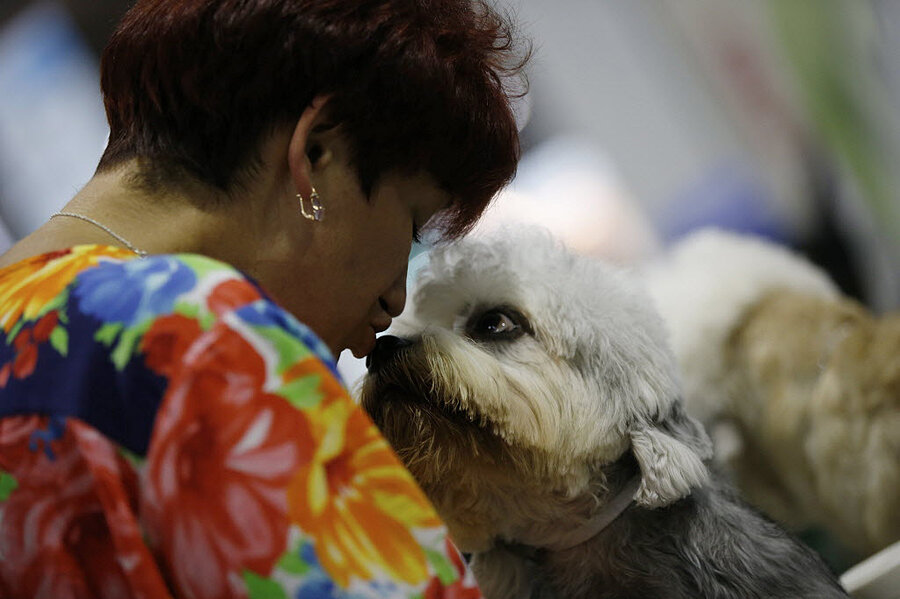Is your dog good with faces?
Loading...
Humans know a face when they see one. Whether it’s in a two-dimensional image, attached to a real-life body, or in the surface of a planet, the facial form has a unique way of registering in the minds of humans and primates.
But new research shows this facial focus isn't limited to primates; man's best friend is wired to recognize faces, too. Dogs have long been known to show a behavioral response to faces, but a recent study discovered that dogs have a specific spot in their brains that reacts to faces.
In the study published by PeerJ, a team at Emory University put six dogs in fMRI machines and showed them movies of human faces, dog faces, and inanimate objects. They found that a region in the dogs’ temporal lobes lit up "significantly more" in response to faces – of dogs or people – than to objects.
"We were focusing on an area of the brain that we know, in primates and humans, responds specifically to faces, to see if dogs have the same thing," says Emory neuroscientist and study senior author Gregory Berns. "And apparently, they do."
Humans have kept dogs as companions for at least 15,000 years, and previous research suggests they feel the same range of emotions as a human toddler, and view their owners much as toddlers view their parents.
"For social animals," the paper says, "faces are immensely important stimuli, carrying a wealth of information, such as identity, sex, age, emotions, and communicative intentions of other individuals."
So "it’s not too surprising" that dogs are attracted to faces, says Dr. Berns. "Just by interacting with them, we know that."
But until now, this behavioral evidence has been the upper limit of scientific knowledge. Berns and the research team wanted to see if dogs really connect with faces themselves, or if the response is generated by an association – for example, a link between human faces and the expectation of food.
"If that were the case, then we would have expected the response, especially to human faces, to be in reward systems of the brain," Berns says. 'That’s not what we saw. We saw that the response to faces was more in the visual system, which suggests it’s more hardwired or innate – that their brains come that way, already ready to respond to faces."
Did this "innate" preference for faces develop over millennia of living with humans, or is it a trait shared by all social creatures?
Researchers still aren't sure, but Berns says he believes the latter is true: as dogs evolved from wolves, they took with them the part of the brain that connects with faces. "I suspect if we could do this in wolves that we’d find the same thing.… maybe not to human faces, but certainly to wolf faces," he says. "Because it’s in such a primary sensory area of the brain and the visual system, I suspect that it’s common in all social species."
The study did not reveal whether react differently to the faces of their owners versus those of strangers, says Berns. "When we started this experiment, we had used pictures of the owners’ faces … We didn’t find anything. But that doesn’t mean that they don’t recognize familiar faces," he says.
The study also didn't examine whether dogs can recognize emotions implied by distinct facial expressions, since the faces used in the study presented neutral expressions, though other research suggests this is possible. Berns also says he doubts that dogs experience facial "pareidolia" – a tendency of humans and primates to interpret any three circles in roughly the right distribution as two eyes and a mouth – though the study did not explore the phenomenon.
The study only used six dogs, but Berns says that doesn't limit the implications of their work. Although only those six could be trained to stay still, unrestrained and unsedated, in an fMRI while continuously watching images, the fact that the researchers consistently saw activity in the part of the brain they were looking for is enough.
"This is kind of more of an ‘existence’ question," Berns says. "Can we demonstrate in any dogs that they have these face regions? And the answer is yes. So the existence is there … It really wouldn’t matter if only one dog had it. The fact that we can find it in a dog, let alone six dogs, shows it’s not something that’s specific to humans or monkeys or apes."






